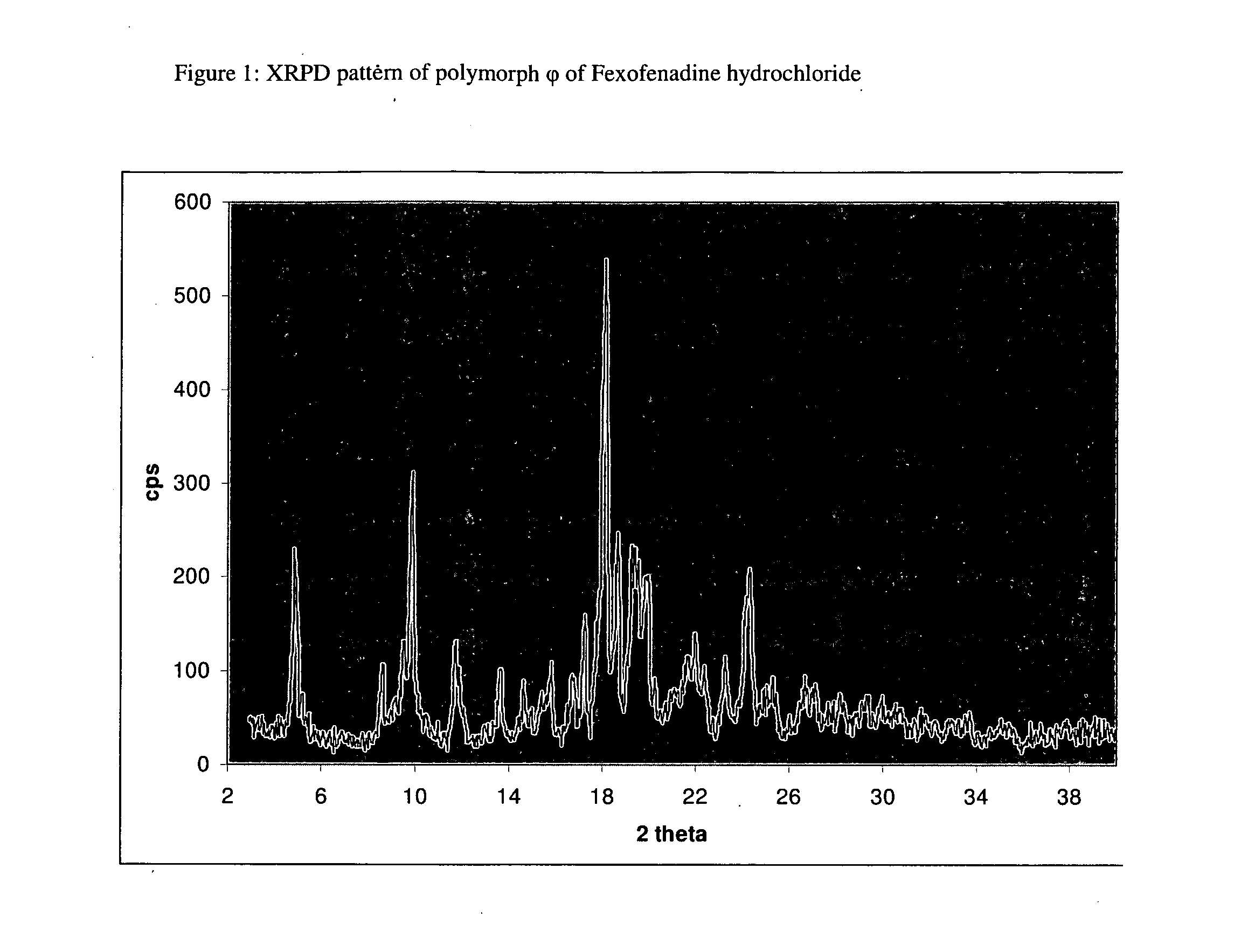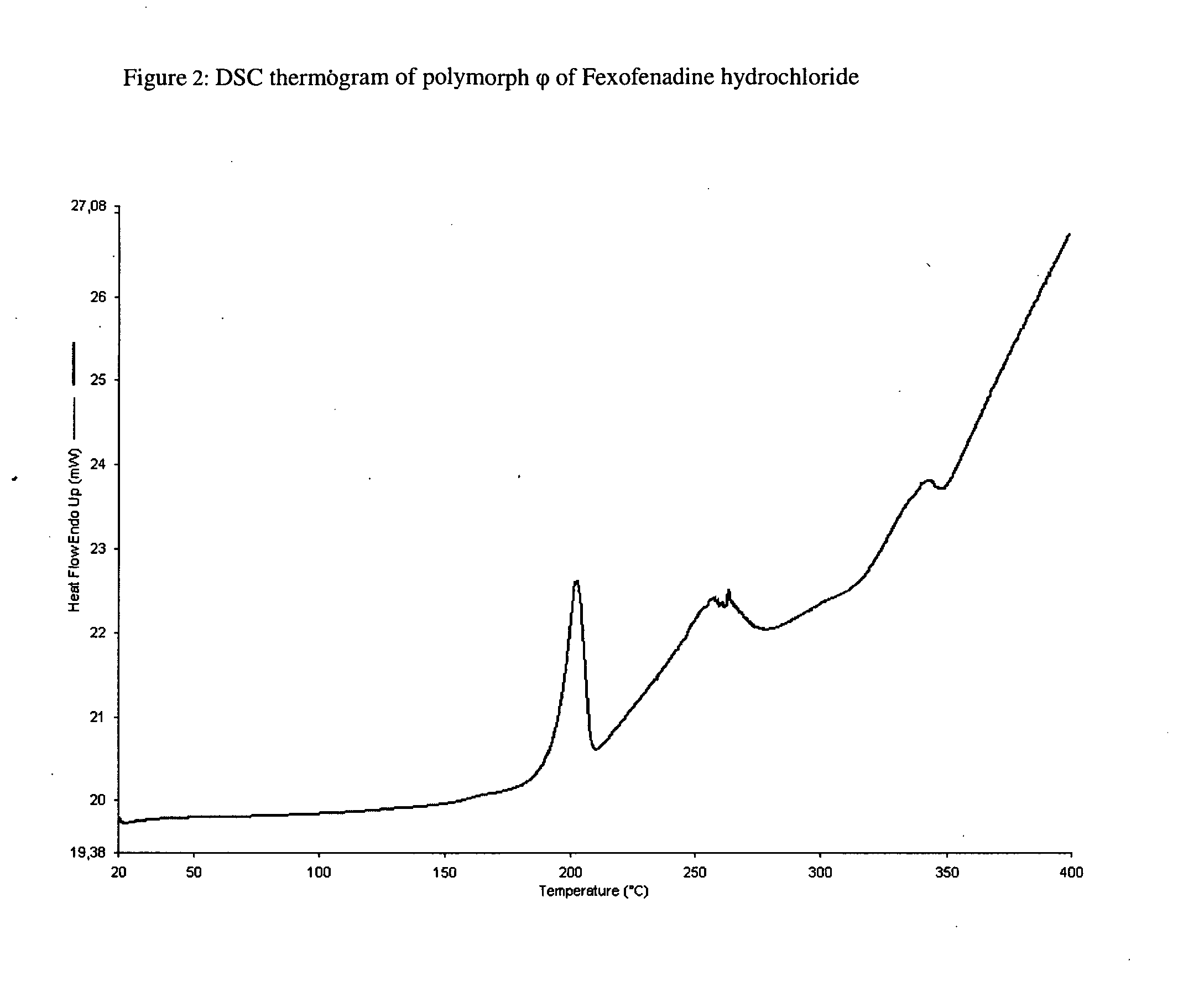Polymorphic form of fexofenadine hydrochloride, intermediates and process for its preparation
a technology of fexofenadine hydrochloride and polymorphic form, which is applied in the field of polymorphic form of fexofenadine hydrochloride, can solve the problems of difficult filtering or separation from the reaction or crystallization medium, fexofenadine hydrochloride, and extremely hygroscopic and/or deliquescent, etc., and achieves stable pharmaceutical composition and easy handling
- Summary
- Abstract
- Description
- Claims
- Application Information
AI Technical Summary
Benefits of technology
Problems solved by technology
Method used
Image
Examples
example 1
Methyl 2-(4-(4-(4-(hydroxydiphenylmethyl)piperidin-1-yl)but-1-ynyl)phenyl)-2-methyl propionate oxalate (II)
[0069]In a 2 L four-neck flask equipped with mechanical stirrer, a thermometer and condenser, isopropanol (1 L) and methyl 2-(4-(4-(4-(hydroxydiphenylmethyl)piperidin-1-yl)but-1-ynyl)phenyl)-2-methylpropionate (82.4 g, 166 mmol) were added. The solution was heated to reflux under vigorous stirring. The solution was cooled to 40° C. and oxalic acid (15 g, 167 mol) was added. The solution was cooled to room temperature and stirred for 4 hours, to crystallize the oxalate salt. The solid was filtered, washed with isopropanol (200 mL) and dried under vacuum at 40° C., to give 94.4 g of (II), as a white solid. Yield: 94%.
example 2
Methyl 2-(4-(4-(4-(hydroxydiphenylmethyl)piperidin-1-yl)but-1-ynyl)phenyl)-2-methyl propionate (III)
[0070]In a 5 L four-neck flask equipped with mechanical stirrer, a thermometer, a condenser and a dropping funnel, toluene (2 L), water (1 L) and methyl 2-(4-(4-(4-(hydroxydiphenylmethyl)piperidin-1-yl)but-1-ynyl)phenyl)-2-methylpropionate oxalate (II) (403 g, 688 mmol) were added. Under stirring, a water solution of ammonia (24%, 100 g, 1410 mmol) was added until pH 9 was reached. The phases were separated, the organic phase was washed with water (500 mL) and concentrated under vacuum to obtain 340 g of (III). Yield: 99.7%.
example 3
2-(4-(4-(4-(Hydroxydiphenylmethyl)piperidin-1-yl)butanoil)phenyl)-2-methylpropanoic acid (V)
[0071]Methyl 2-(4-(4-(4-(hydroxydiphenylmethyl)piperidin-1-yl)but-1-ynyl)phenyl)-2-methyl propionate (III) (340 g) is dissolved in methanol (1790 mL). A solution of water (185 mL), sulfuric acid 98% (72 g, 722 mmol) and mercuric oxide (4.1 g, 19 mmol) was dropped: the temperature was maintained at about 40° C. The reaction was stirred for 8-10 hours and monitored by HPLC. At the end of the reaction, the mixture was dropped to a solution of sodium hydroxide (130 g, 3250 mmol) in methanol (650 ml) and water (200 mL). At reflux temperature, acetic acid (115 g, 1920 mmol) was added. The suspension was then cooled to 25-30° C. The solid was filtered under vacuum and washed with methanol (2×100 mL). The humid solid recovered was suspended in water (950 mL) and heated to 60-65° C. for about 1 hour. The solid was filtered and washed with hot water (2×100 mL), water at room temperature (2×100 mL) and ...
PUM
| Property | Measurement | Unit |
|---|---|---|
| temperature | aaaaa | aaaaa |
| temperature | aaaaa | aaaaa |
| temperature | aaaaa | aaaaa |
Abstract
Description
Claims
Application Information
 Login to View More
Login to View More - R&D
- Intellectual Property
- Life Sciences
- Materials
- Tech Scout
- Unparalleled Data Quality
- Higher Quality Content
- 60% Fewer Hallucinations
Browse by: Latest US Patents, China's latest patents, Technical Efficacy Thesaurus, Application Domain, Technology Topic, Popular Technical Reports.
© 2025 PatSnap. All rights reserved.Legal|Privacy policy|Modern Slavery Act Transparency Statement|Sitemap|About US| Contact US: help@patsnap.com



